For cooking, processing water, heating and defense from the night, there’s nothing like it. Here’s how to summon a flame when you need it.
Before starting an outdoor adventure, I go through my gear to make sure it’s all present and in working order.
My principal items—food, water and shelter—are physical things that I can touch. However, one necessity in most situations is fire. I can’t carry fire in my backpack, only the tools and materials that have the potential to aid in the creation of fire. Read that last part again. Only through knowledge and skill can I effectively put those tools to use to start a fire.
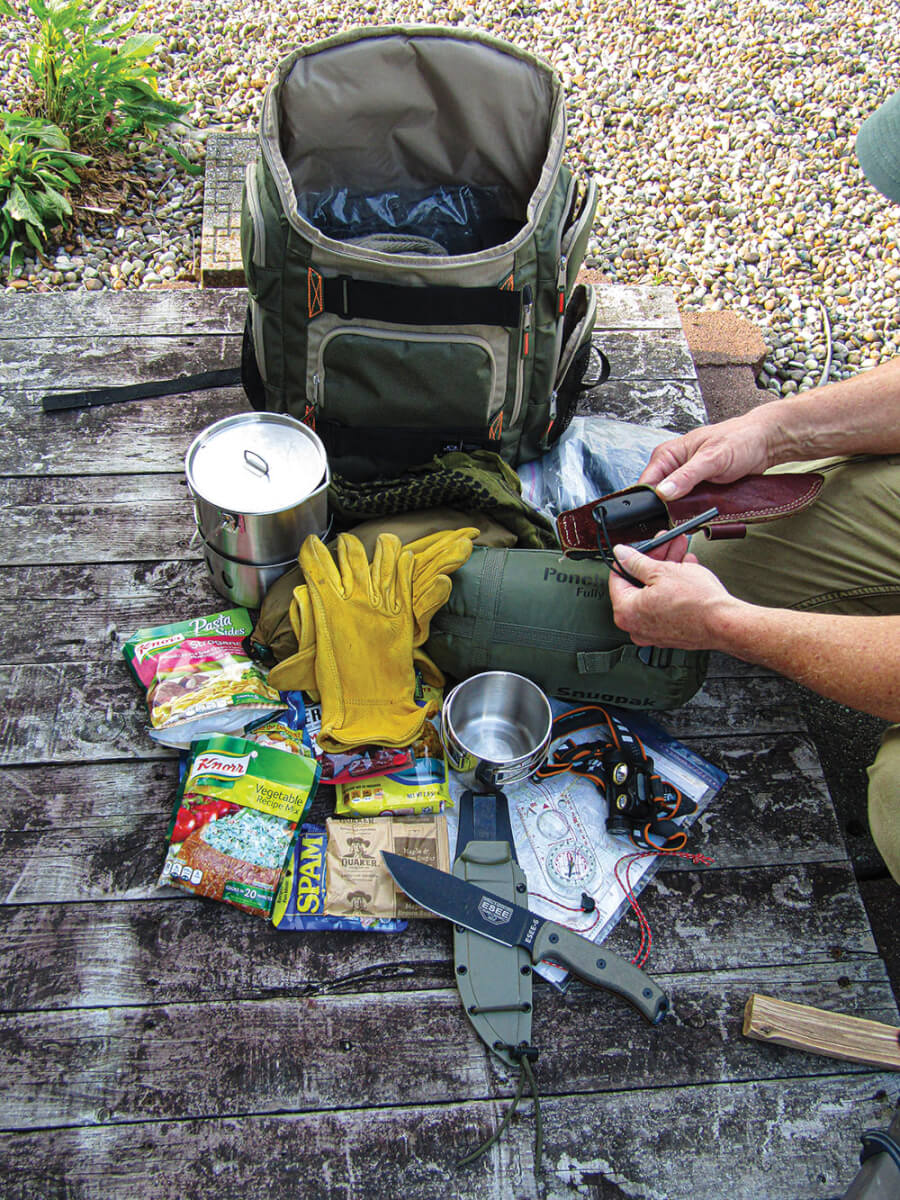
START WITH THE BASICS
“Firecraft” encompasses the skills and knowledge necessary to create fire from materials found in the environment. By developing the skills to make and use the tools, and through the knowledge of what materials work best under which circumstances, it’s possible to step back to the days before matches and disposable lighters and reclaim a survival skill that’s been all but forgotten over the last couple of generations.
There might come a time when these antiquated or primitive methods could save your bacon … or at least allow you to cook it.
Every campfire requires a few basic ingredients:
- Ignition source
- Tinder
- Kindling
- Air
- Fuel
Assuming there’s a supply of firewood and air in the environment, this article will focus on the first two items: ignition sources and tinder.
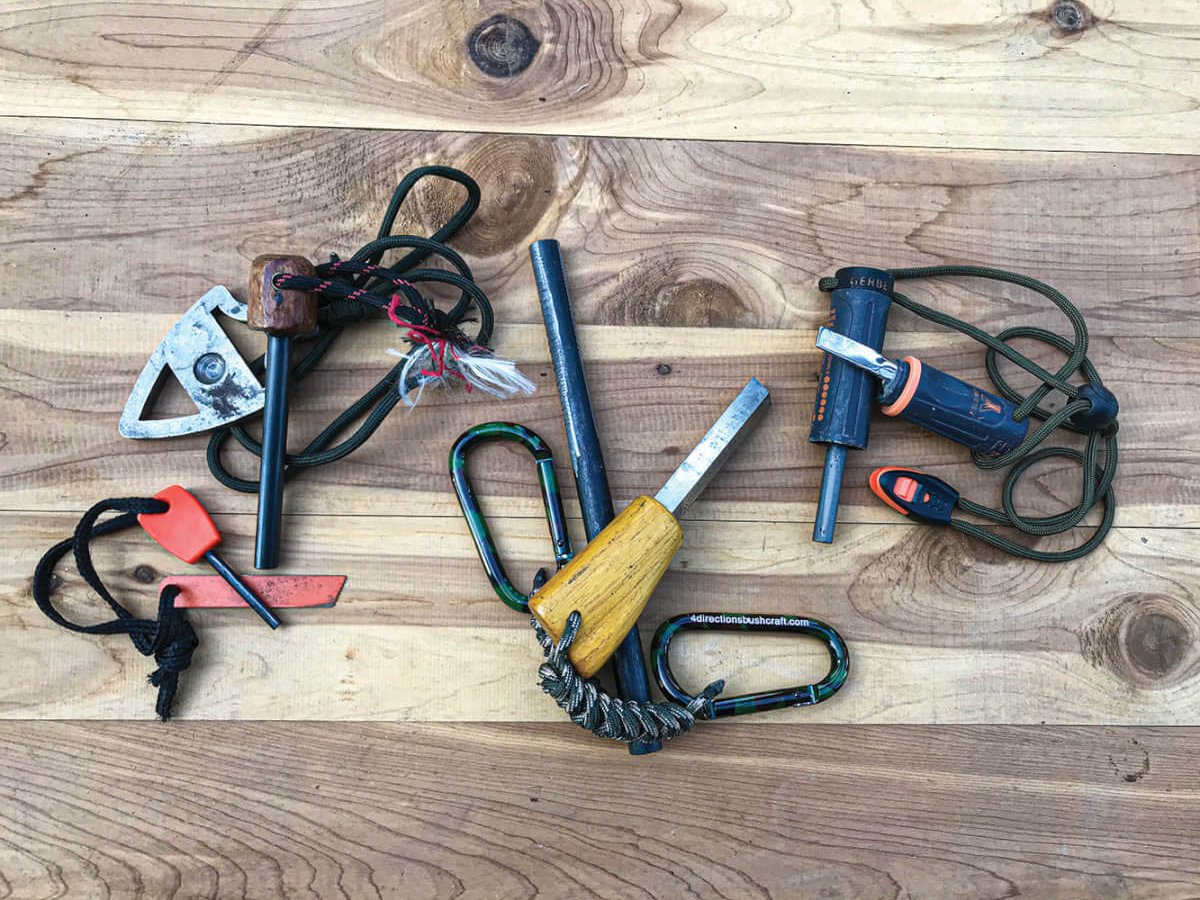
IGNITION SOURCES
Ignition sources include flint and steel, a magnifying glass and friction (ignition is achieved by the heat generated when grinding two pieces of wood together). Ferrocerium (ferro) rods are modern alternatives to flint and steel and are extremely effective at ignition. Their all-weather performance makes them great choices for emergency situations or as backups when other methods aren’t feasible.
Flint and steel. The use of flint and steel dates back thousands of years. Minerals such as iron pyrite produce a spark when struck against flint, chert or similar rocks. Although the spark isn’t hot enough to ignite wood, it can readily ignite materials that have a low ignition temperature to create a burning ember. Once lit, this ember grows and can be used to produce fire.
Flint and chert are commonly found in nature, especially along rivers and streams that once had populations of Native Americans who made tools and weapons from this sharp-edged mineral. Iron pyrite can be a bit harder to find, but high-carbon steel, such as that used for metal files or knife blades, will produce a spark when struck against flint.
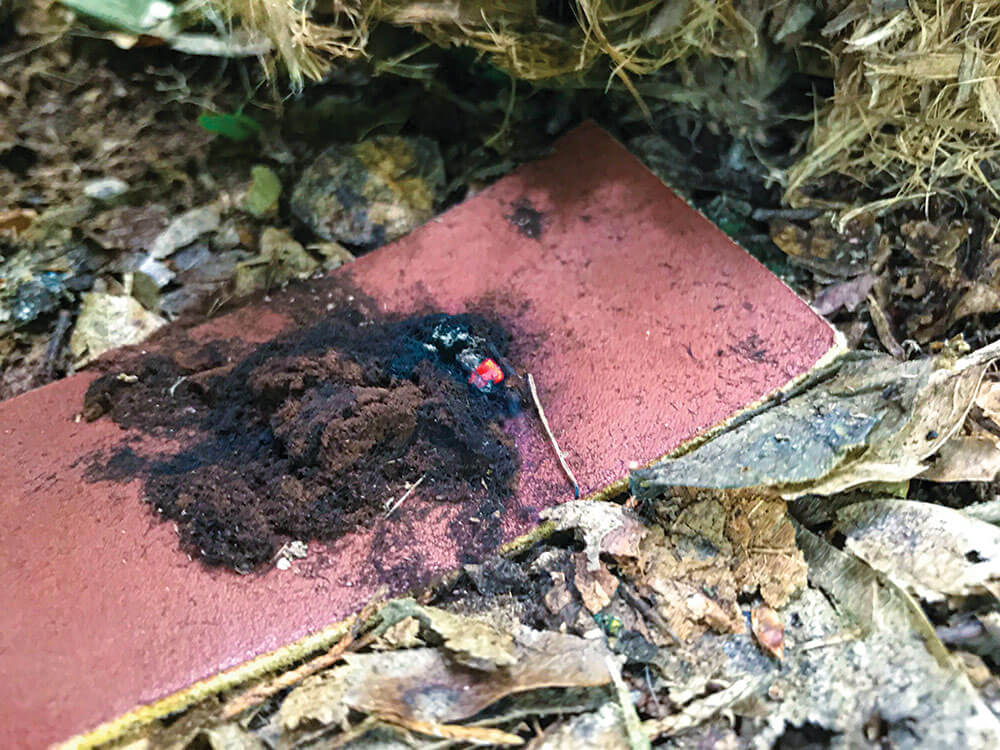
Magnifying lenses. Magnifying lenses have also been around for thousands of years. Their convex lenses can be used to concentrate sunlight into a tiny spot on combustible material to create intense heat—which leads to ignition. Lenses can be made from glass, clear ice or plastic.
Glass lenses can be scavenged from optical devices such as binoculars or rifle scopes. In addition, many baseplate compasses used for land navigation feature an integrated magnifying lens that works very well for igniting charred tinder. This dual-purpose capability adds another reason to include a compass in your gear.
Fire drills. Fire drills, including hand drills and bow drills, have been in use for thousands of years to create a spark. When a wooden spindle is rapidly rotated against another piece of wood, dust and heat are produced.
The heat causes the dust to char and, once an accumulation of charred material reaches its ignition point, an ember is formed. This ember spreads through the remaining dust, creating a smoldering mass that can be transferred to a tinder bundle and brought to flame.
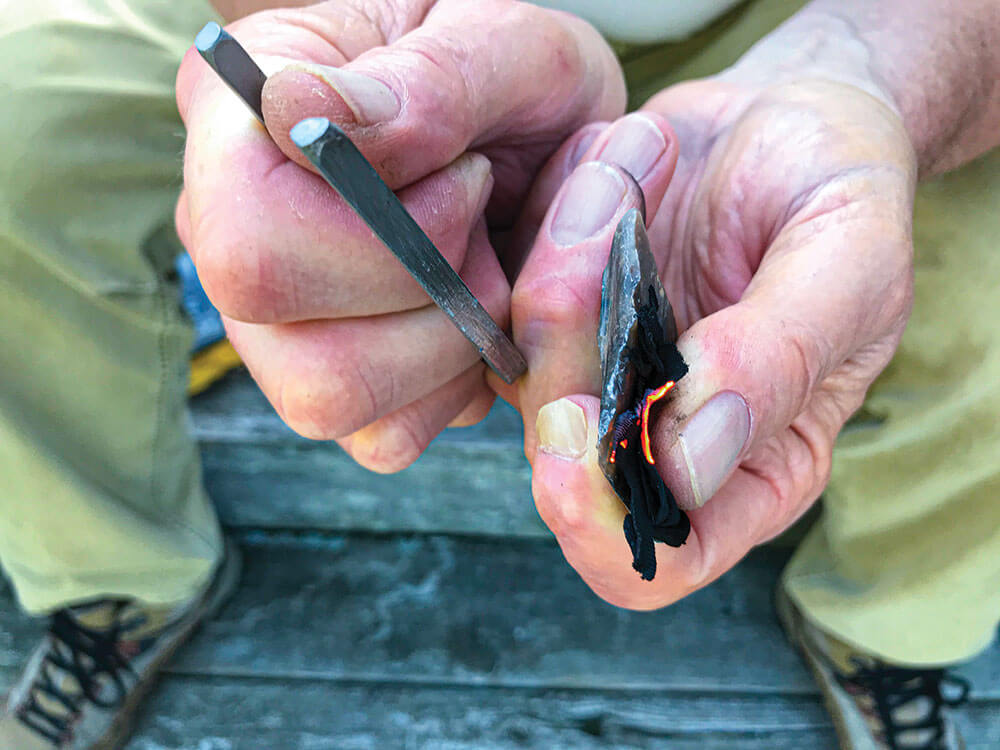
A hand drill requires only two pieces of wood: the spindle and the fire board. The spindle is spun between the palms of the hands with downward pressure applied. A bow drill is more complex, requiring a makeshift bow with a piece of cordage fastened at each end. This cord or string is wrapped around the spindle, causing it to spin when the bow is moved back and forth.
A handhold or bearing surface is placed on the top of the spindle to keep it centered above the fireboard and allows downward pressure to be applied. The mechanical advantage of the bow drill makes it superior to the hand drill, and it’s a bit easier to master.
Ferrocerium. Ferrocerium is a metal alloy invented in 1903. When scraped forcefully with a sharp-edged object, tiny pieces of the alloy are torn away and are oxidized by contact with the air. These fragments immediately produce tremendous heat (more than 5,000 degrees (F) that’s able to ignite almost any flammable substance they contact.
Tiny rods of ferrocerium are used in many lighters to make the spark that ignites the fuel. Larger ferro rods are often included in survival kits or incorporated into fire-starting products.
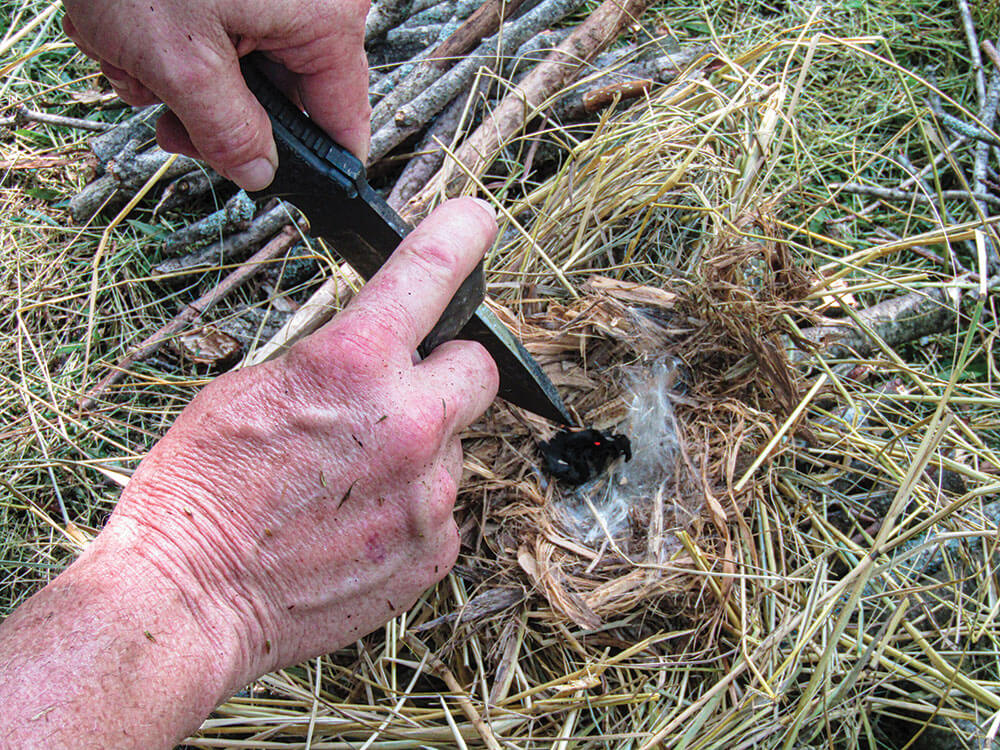
Tinder. Tinder is material that’s easy to ignite. Examples include dry grasses and weeds, fine wood shavings and certain types of tree bark. These can be lit by a small flame or hot sparks from a ferro rod. Some materials are better suited when a comparatively weak spark is used, such as that from flint and steel, or when using a magnifying lens.
Charred materials, such as char cloth, charcoal and certain fungi, will catch a spark and ignite to create an ember. This ember can then be used to ignite a tinder bundle to produce flame.
‘NEXT FIRE’ MENTALITY
A term often used in the bushcraft community, “next fire mentality,” is the thoughtful effort to take advantage of a current fire to carry something forward to the next fire. This can be drying damp tinder that was collected to start the fire or collecting/creating charred materials.
These are pieces of burning wood that can be pulled from the fire and extinguished by covering with dirt, sand or ashes. Once the oxygen is cut off, combustion stops, and the charred wood can be placed in a pouch or container for rekindling later.
Another method is the charring tin. A charring tin is a small, metal box into which combustible materials are placed. Then, it’s closed and pushed into the fire to cook. This cooking process drives off all the volatile compounds, leaving mostly carbon. Because this takes place inside the tin in an oxygen-free environment, complete combustion isn’t possible. What remains is very easily lit with even a weak spark or brief touch of focused sunlight. Cotton cloth, wood shavings, punkwood, fungi and many other natural materials can be charred.
However, synthetic compounds such as nylon and polyester will simply melt and make a useless mess, so don’t use them.
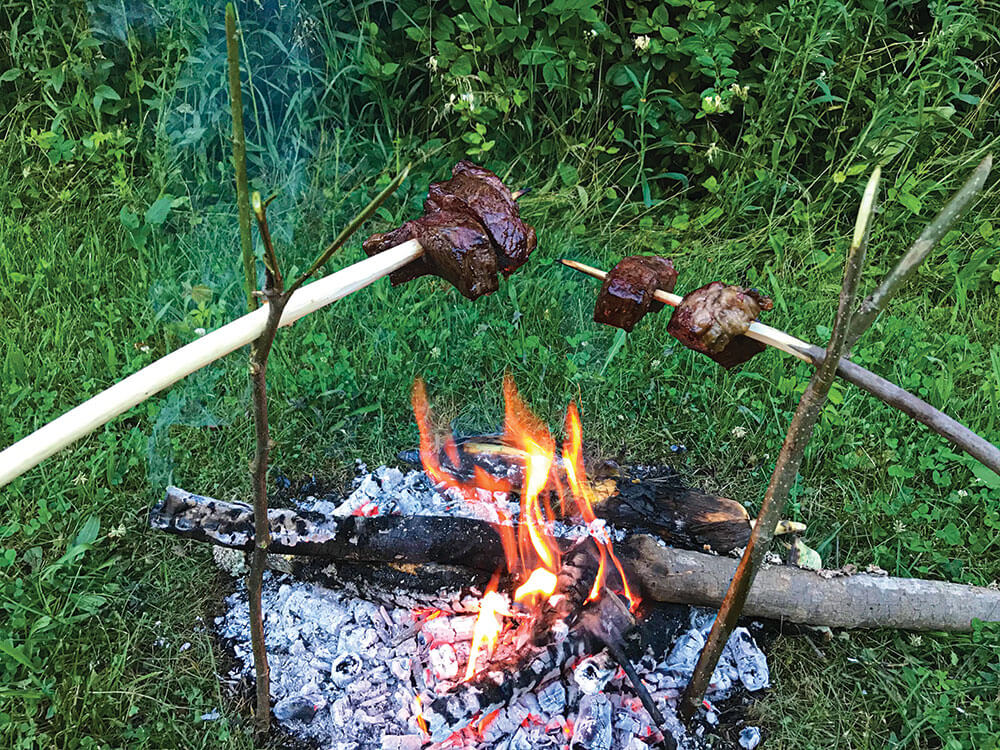
Leave the tin in the fire for 15 to 20 minutes to thoroughly cook its contents. Use a stick to drag the tin clear of the coals and allow it to cool completely before you open it. If oxygen enters the tin while the contents are still hot, the charred materials will combust. If, upon inspection, the material isn’t completely charred, slide it back into the fire for a few more minutes. Heat, cool and repeat as necessary.
When adding new material to the charring tin, simply place it in with what’s already inside. There’s no need to remove the stuff that’s already charred, because it won’t hurt to cook it again.
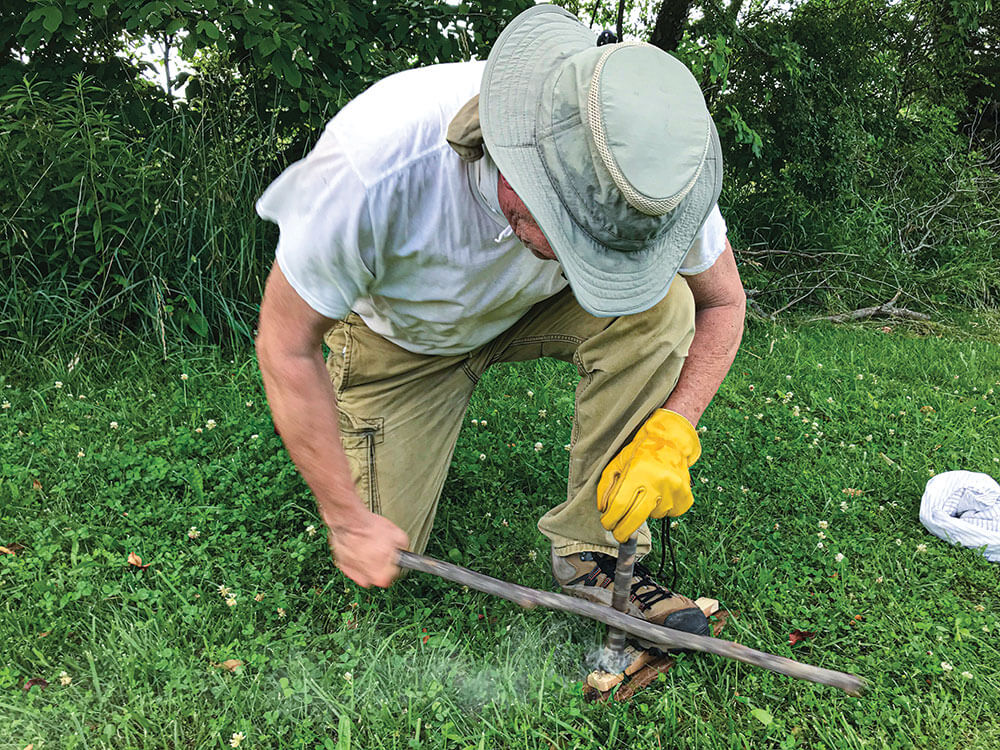
ASSEMBLE A FIRE KIT
I carry the tools and materials used for creating fire in my fire kit. Like a first aid kit for medical purposes, the fire kit has everything needed to start a fire. And, just as different medical situations call for different items, some fire-starting items are more appropriate for certain circumstances than others.
Included items are:
- Flint and a carbon-steel striker
- Cotton balls—plain and with petroleum jelly rubbed in
- Cordage for a bow drill
- Locking-bladed folding knife
- Ferro rod and striker
- Fatwood tinder
- Charring tin
- Magnifying glass
- Disposable lighter
- Waterproof matches
- Zip-top bag
- Plastic grocery bag for collecting tinder
Some of these items have been in my fire kit for decades and have never been used—specifically, the waterproof matches and lighter. While I do carry this kit on occasion, it usually stays in my vehicle. When I’m on foot, I rely on what’s on my belt.
My camp knives all have a ferro rod attached to the sheath in some manner, and a 4-foot-long (or even longer) piece of cordage is wrapped around, or tucked inside, the sheath. Even the multitool I use for working around the homestead has been converted into a self-contained fire kit.
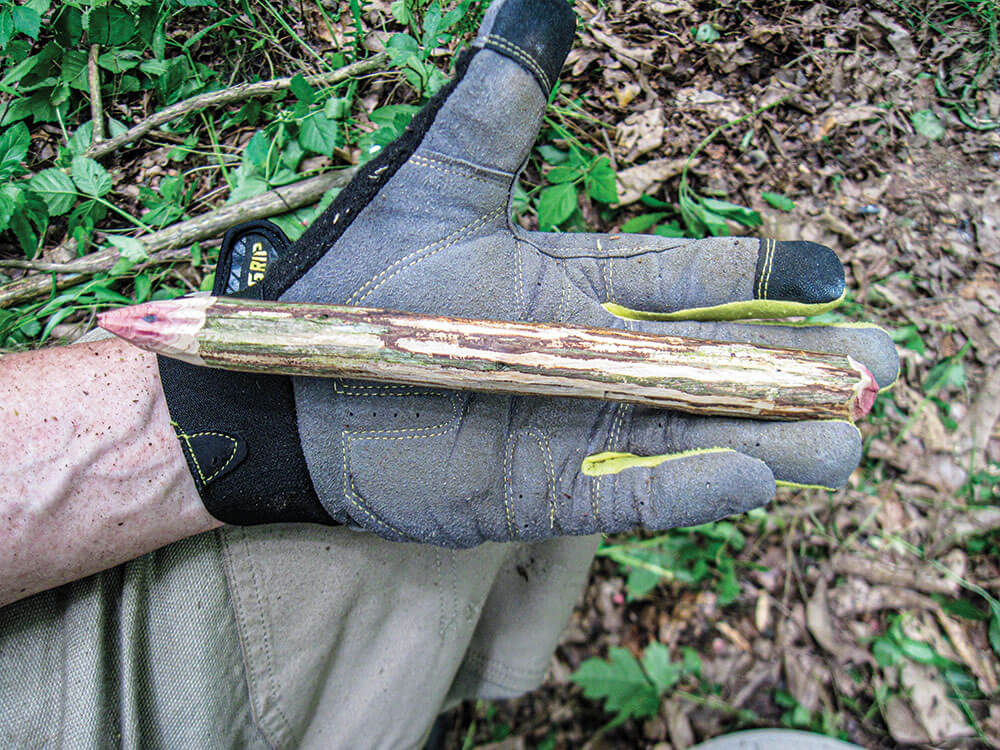
No matter how proficient you are in creating fire with primitive methods, it’s fine—and advisable—to have modern tools available at all times. After all, humans invented these things for a reason. Sure, the old ways work, but mastering them can be a challenge.
Fire-Starting Gear
I’ve used the following products extensively in the field and found them to be excellent fire-starting items. (Some of the items featured in this article’s images might be older versions of what’s produced today. All are currently available but might look a bit different or have new features.)
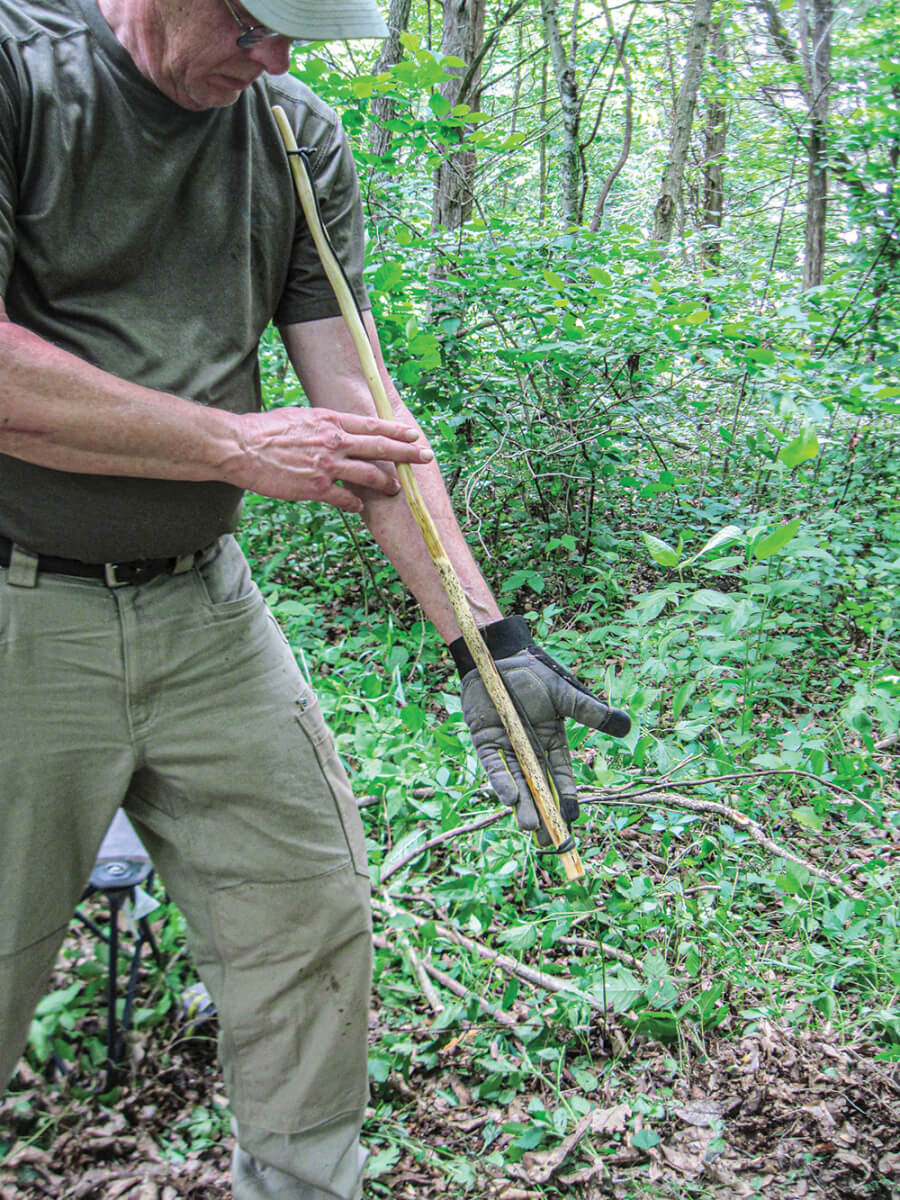
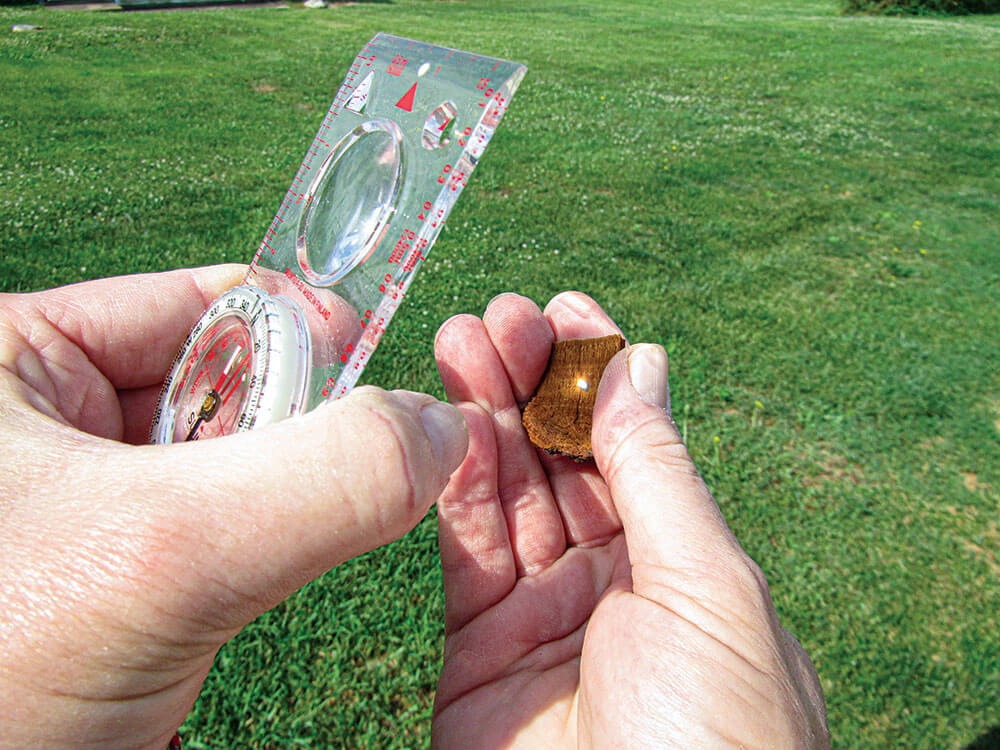
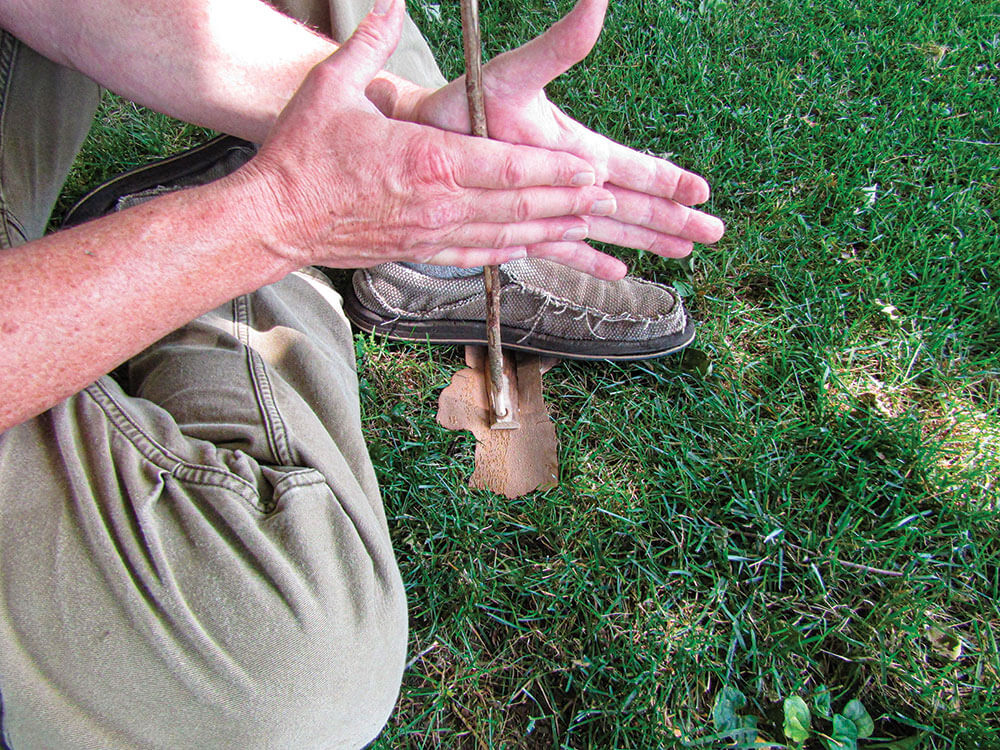
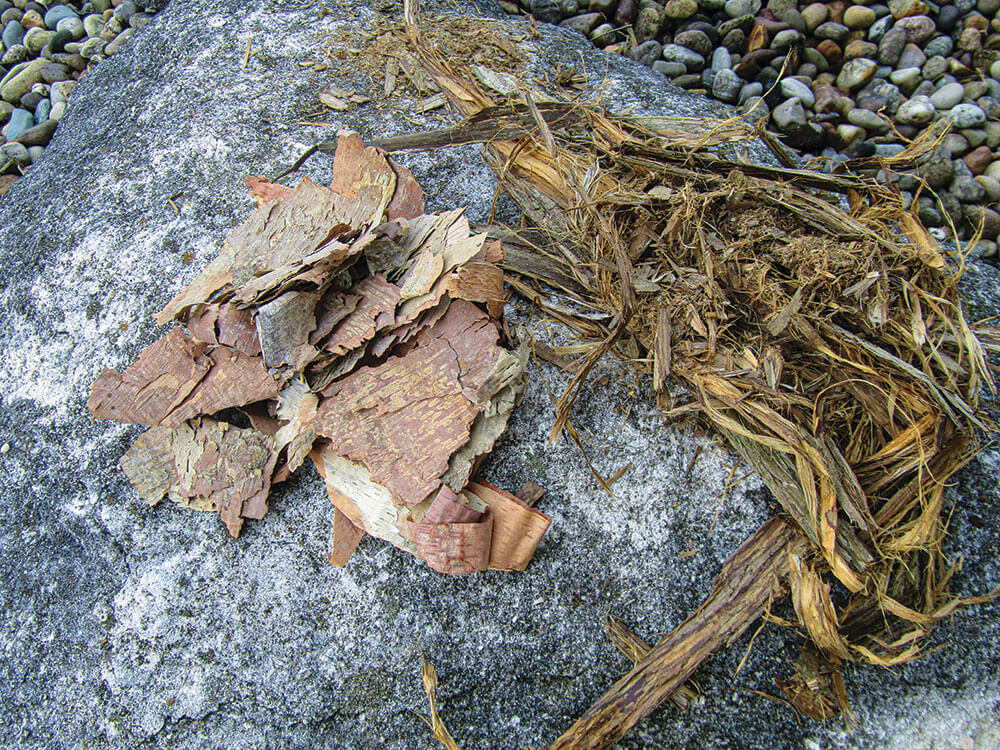
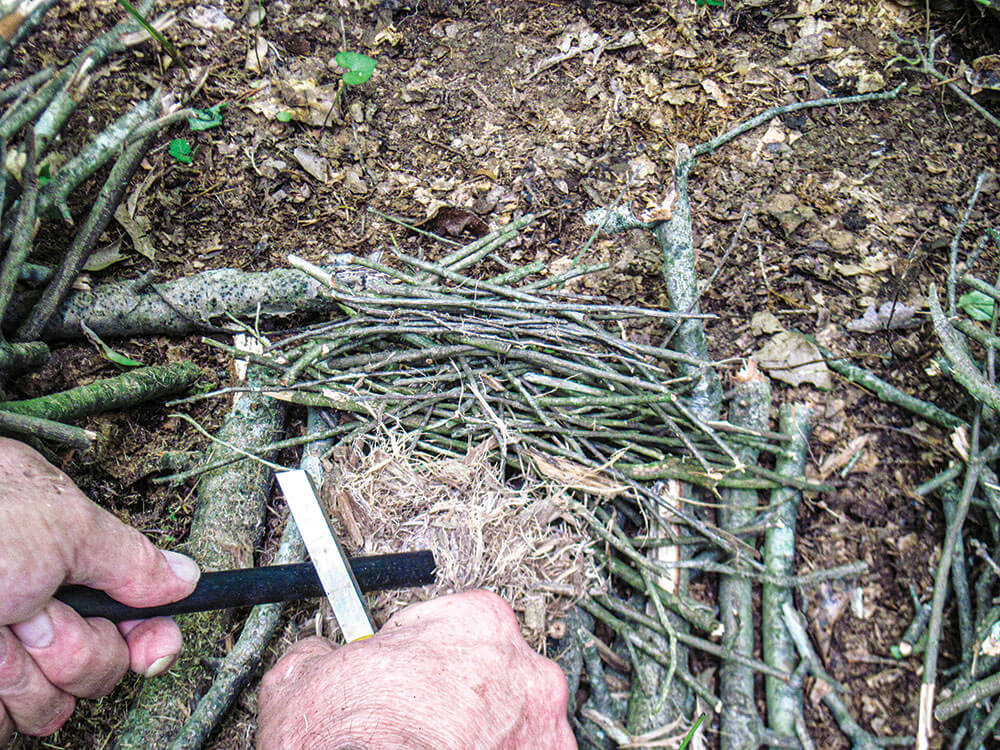
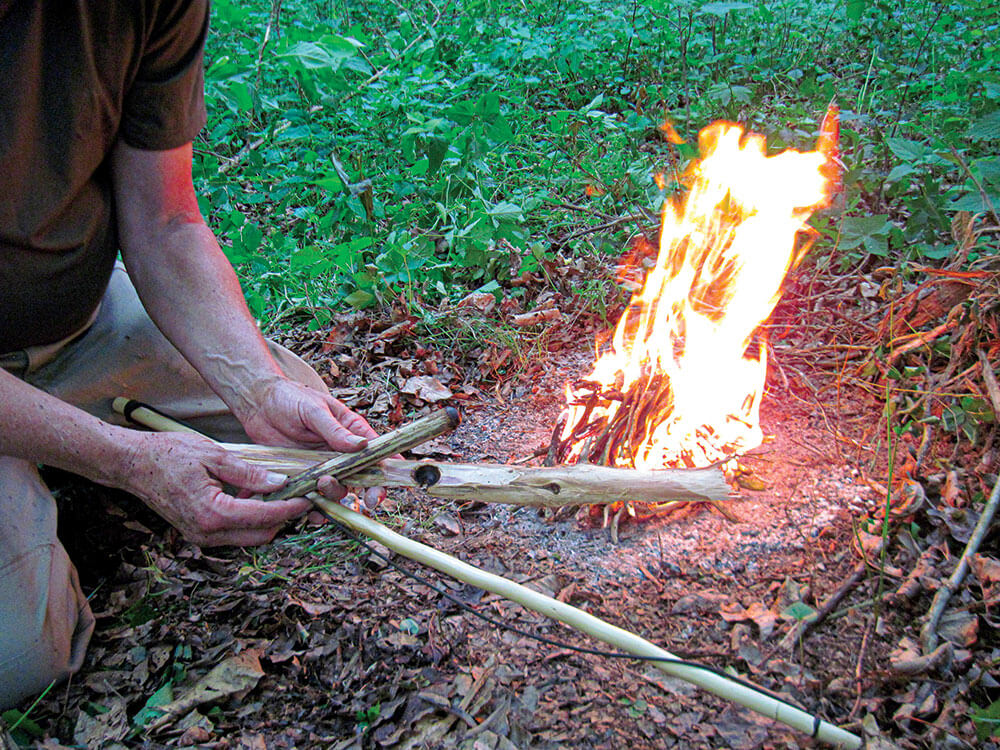
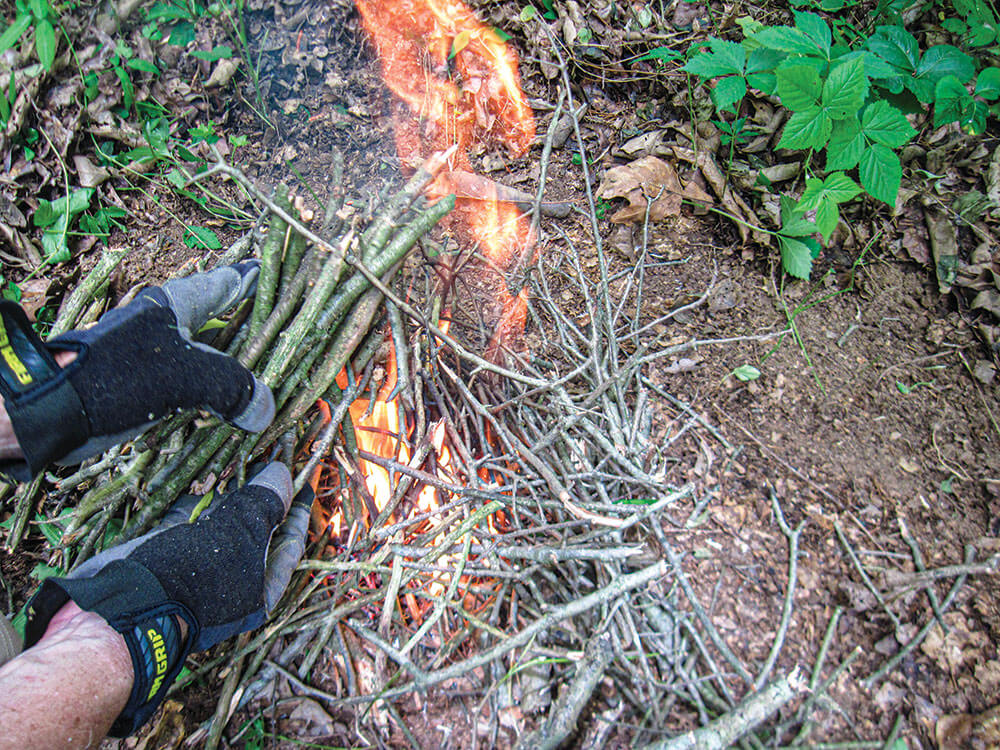
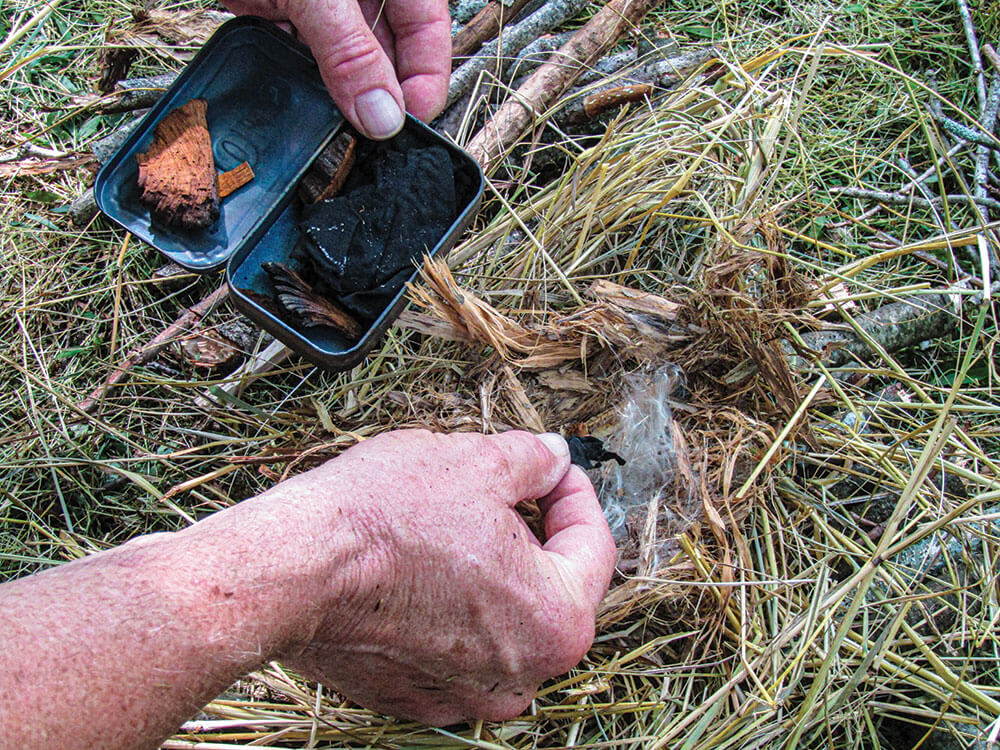
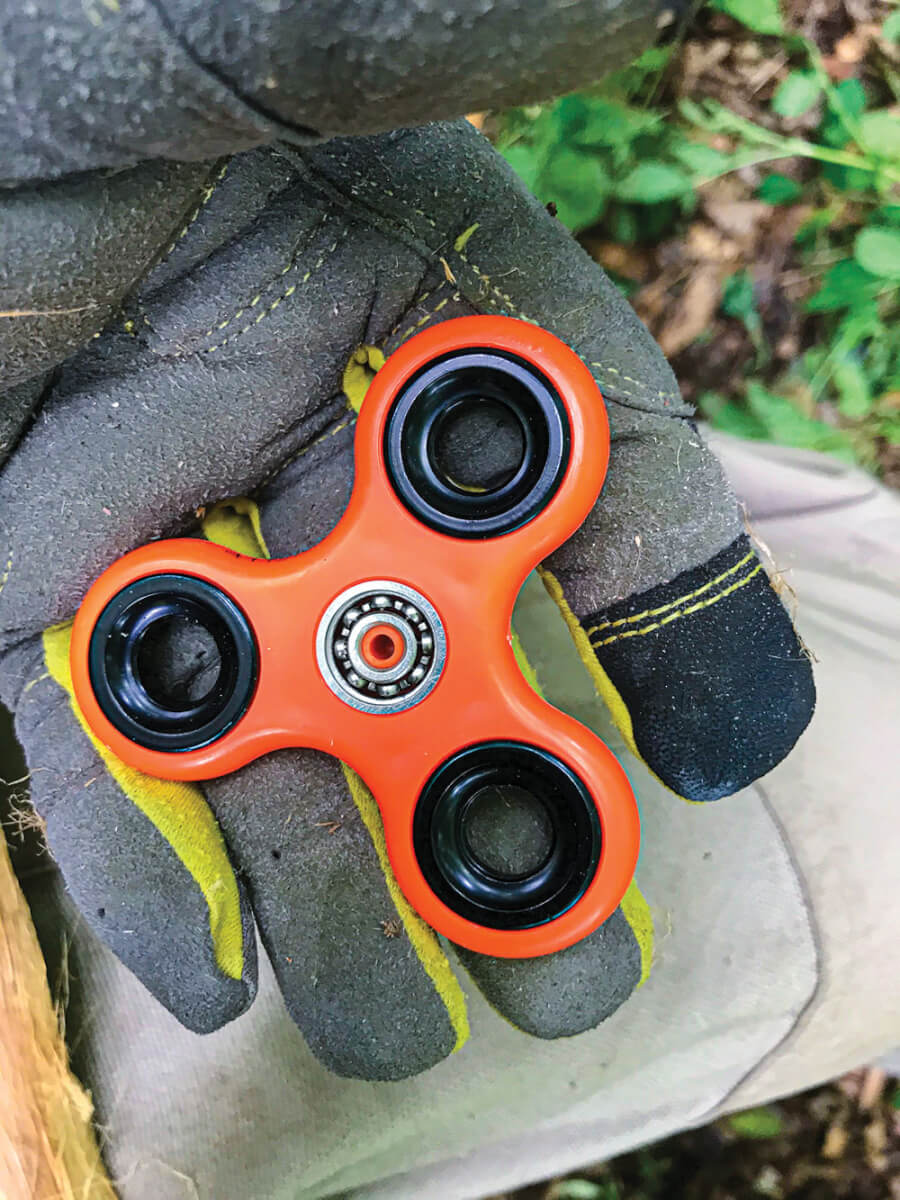
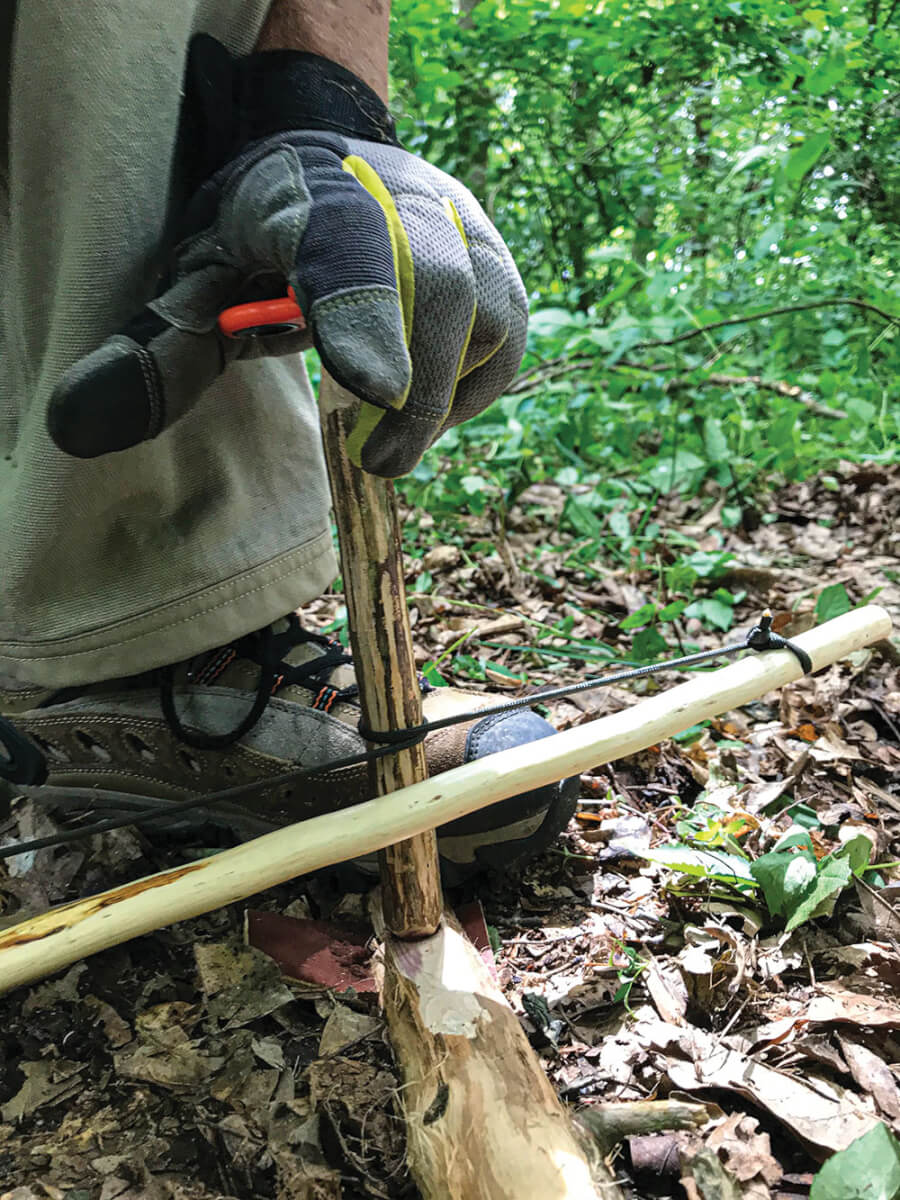
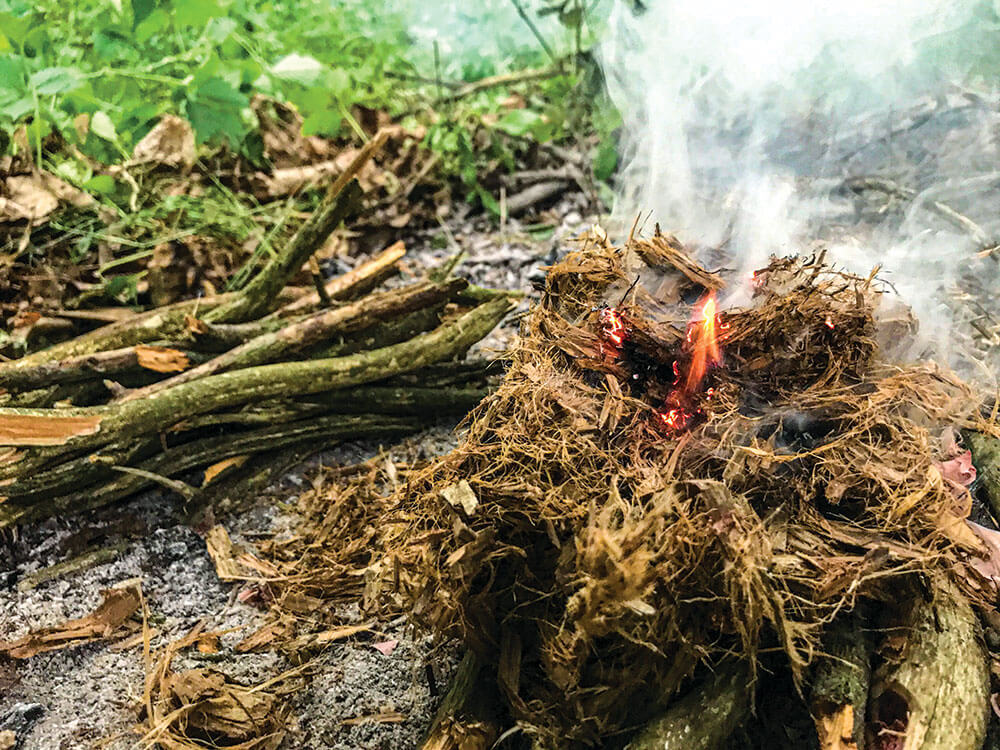
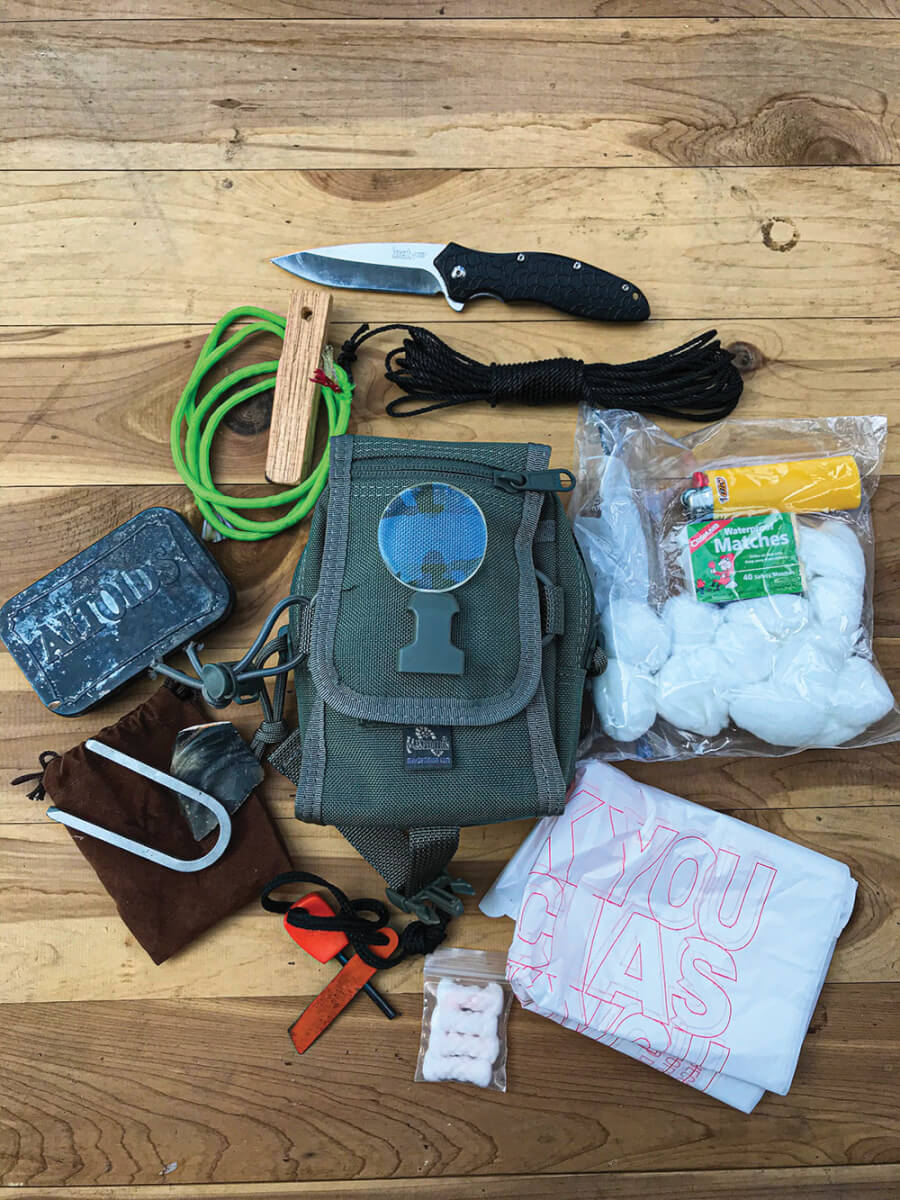
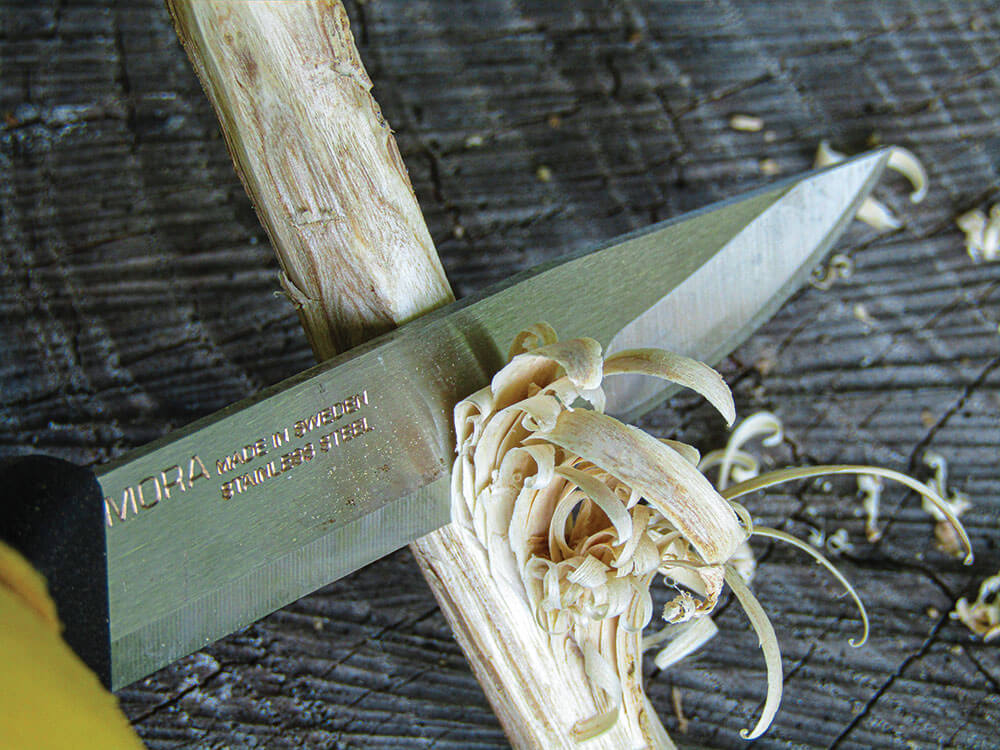
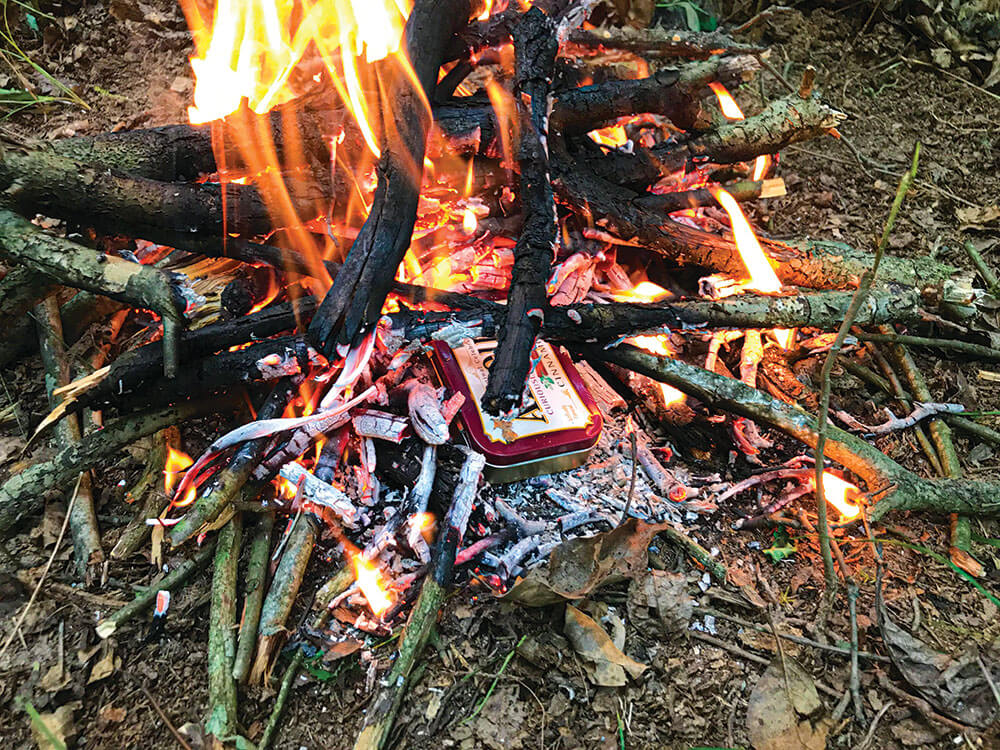
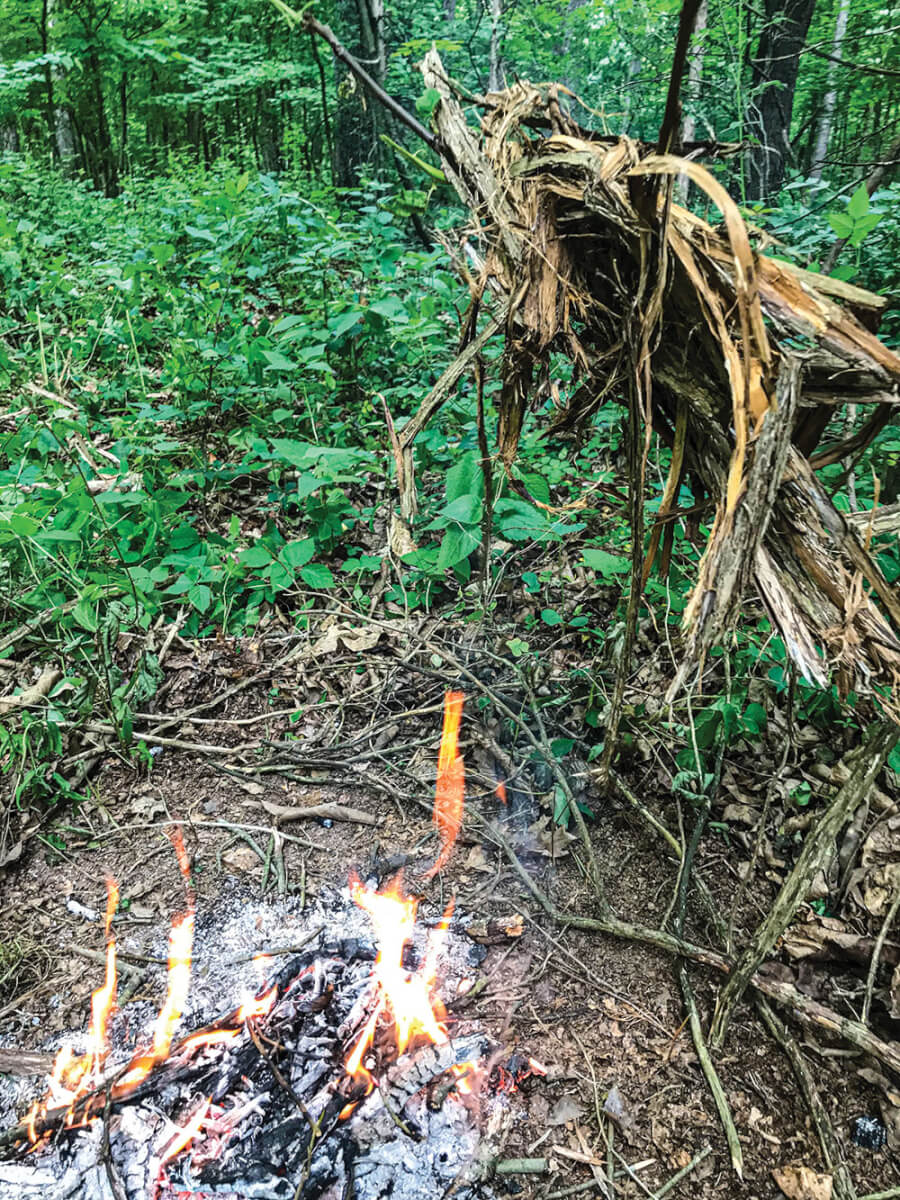
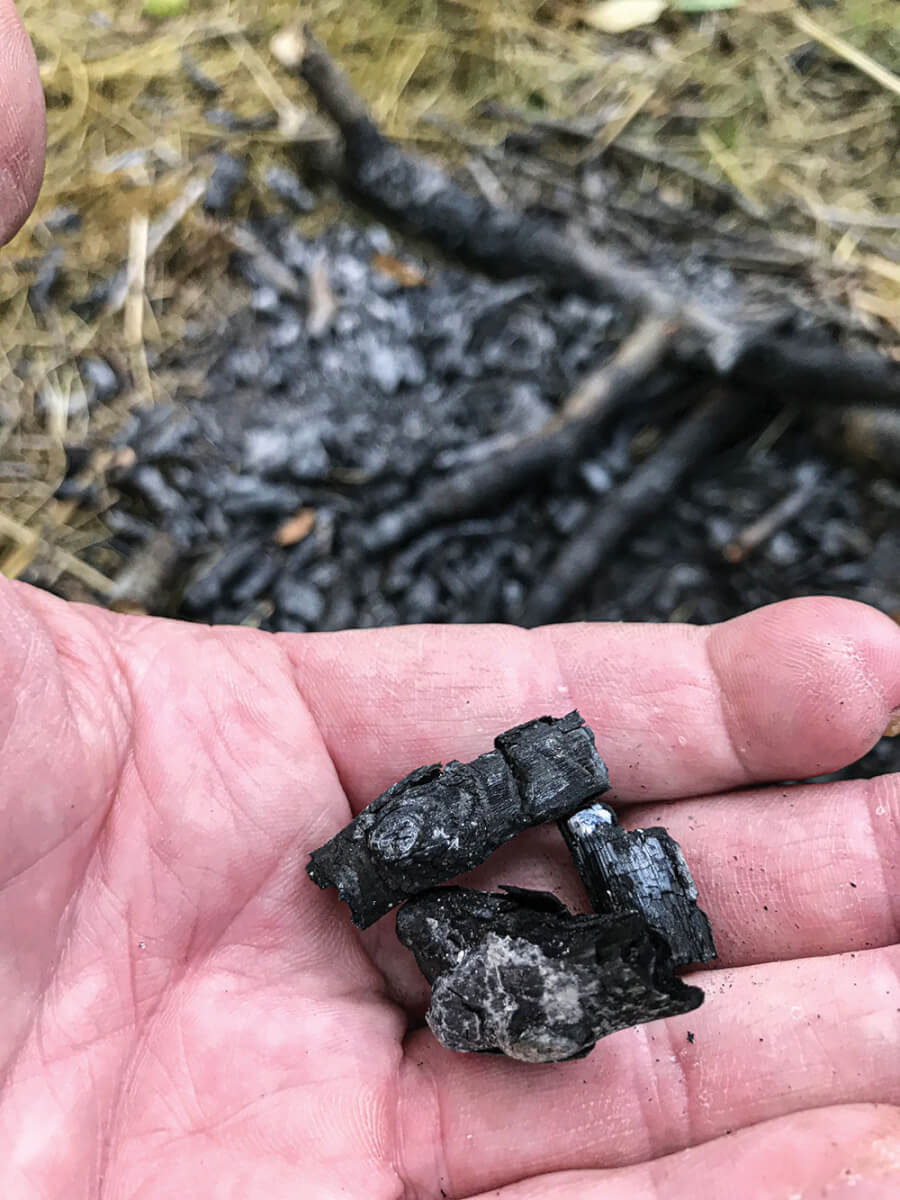
Fire-Starting Gear
I’ve used the following products extensively in the field and found them to be excellent fire-starting items. (Some of the items featured in this article’s images might be older versions of what’s produced today. All are currently available but might look a bit different or have new features.)
PATHFINDER Multi Fire Tool
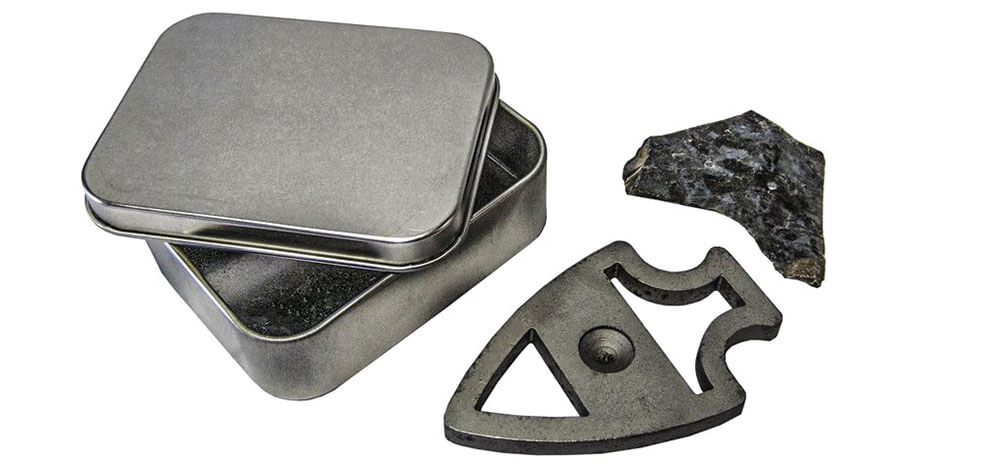
Shaped like an arrowhead, this tool can be used to create fire as a bearing block for bow drills, a striker for a ferro rod and as a striker for use with flint. It’s made from 1095 high-carbon steel to produce good sparks when struck with natural flint.
The divot drilled into one face allows for a secure spindle handhold for bow drill fires. I’ve had mine for several years, and it’s become one of my favorite tools for creating fire. It includes a tin container for charring and storing tinder, as well as a piece of natural flint.
MSRP: $29.95
SelfRelianceOutfitters.com
Zippo Typhoon Match Kit
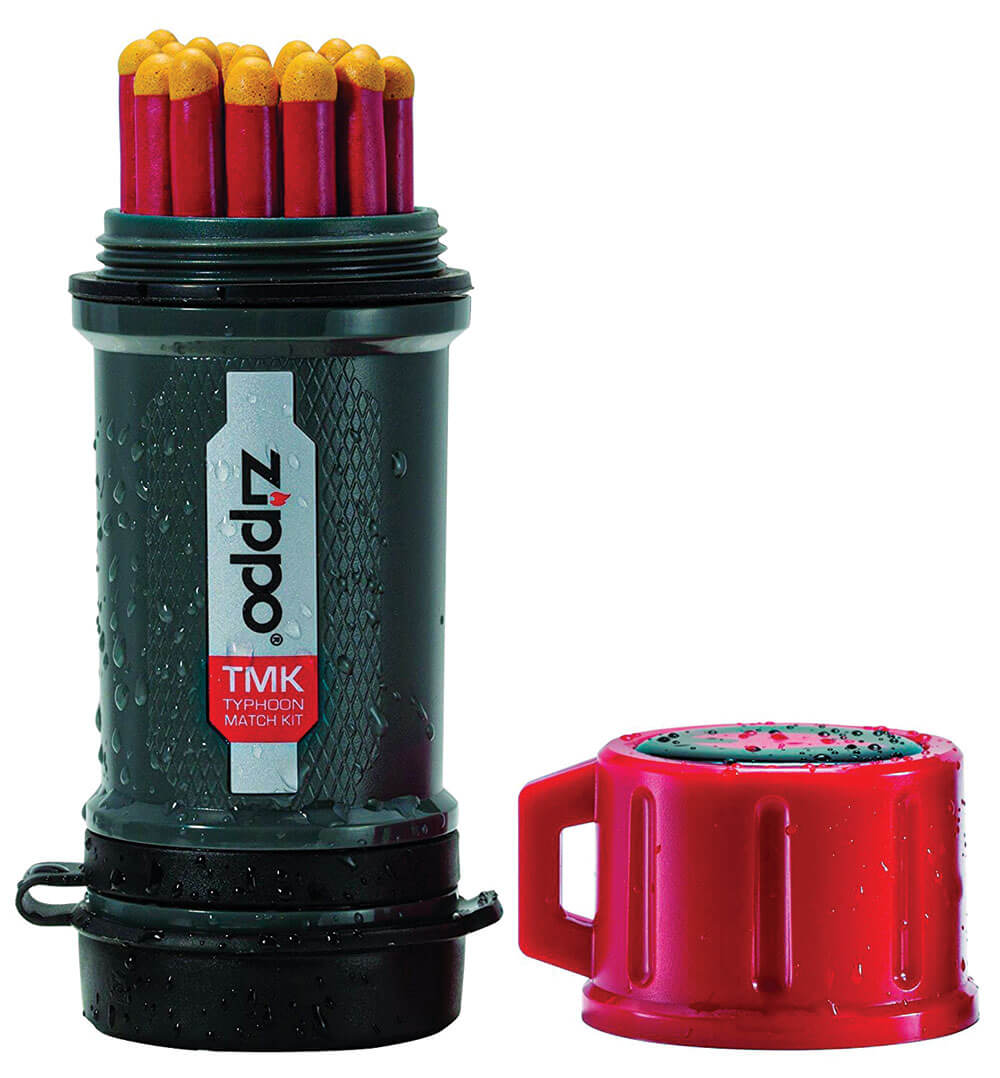
Waterproof matches belong in every fire kit as a last-ditch effort to get a fire started or when circumstances require a fire without delay. This kit’s 4-inch-long matches are designed for extreme conditions and are completely waterproof.
They’ll even reignite after being submerged in water and will burn for approximately 30 seconds. The kit comes with 15 matches, three strike pads and a water-resistant storage chamber that floats.
MSRP: 14.95
Zippo.com
4 Directions Bushcraft Elite Ferrocerium Rod
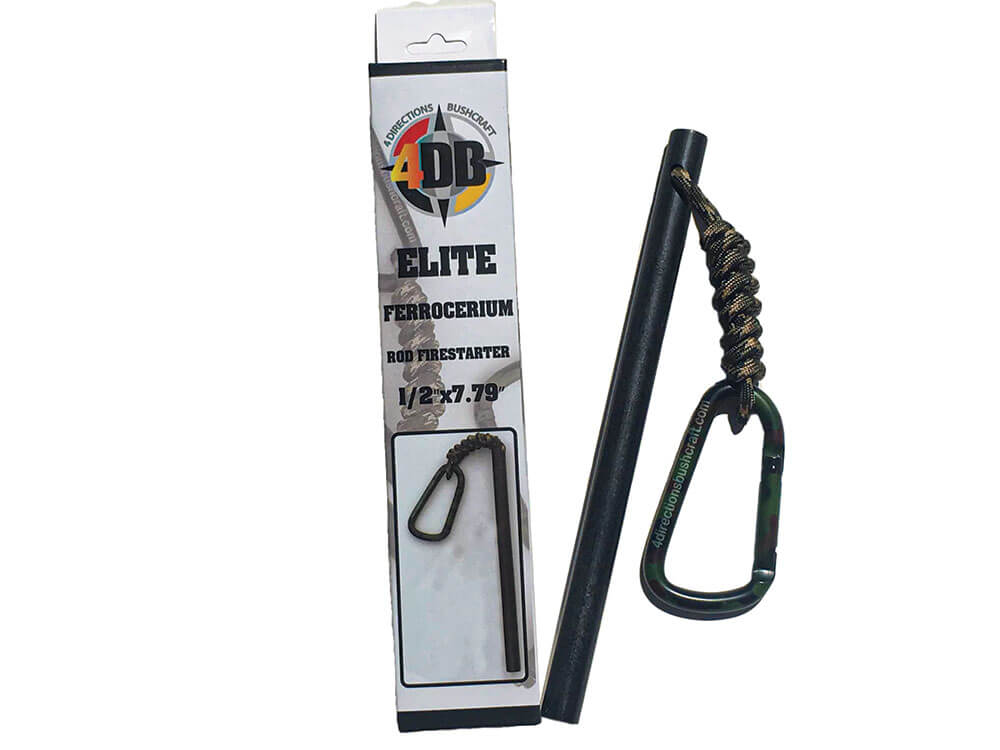
This rod measures a whopping 7.79 inches in length and a full ½ inch in diameter. The extra length and thickness make it very easy to hold with cold or wet hands. The ratio of cerium, magnesium and iron is perfect for throwing gobs of dancing sparks while resisting corrosion when exposed to water. The included carabiner (not rated for climbing) can be fastened to a belt loop to keep the fire starter secure and is attached with 550 parachute cord that features an extra inner strand made of jute twine that can be used as tinder.
MSRP: $21.99
4DirectionsBushcraft.com
4 Directions Bushcraft Tinder Mixer
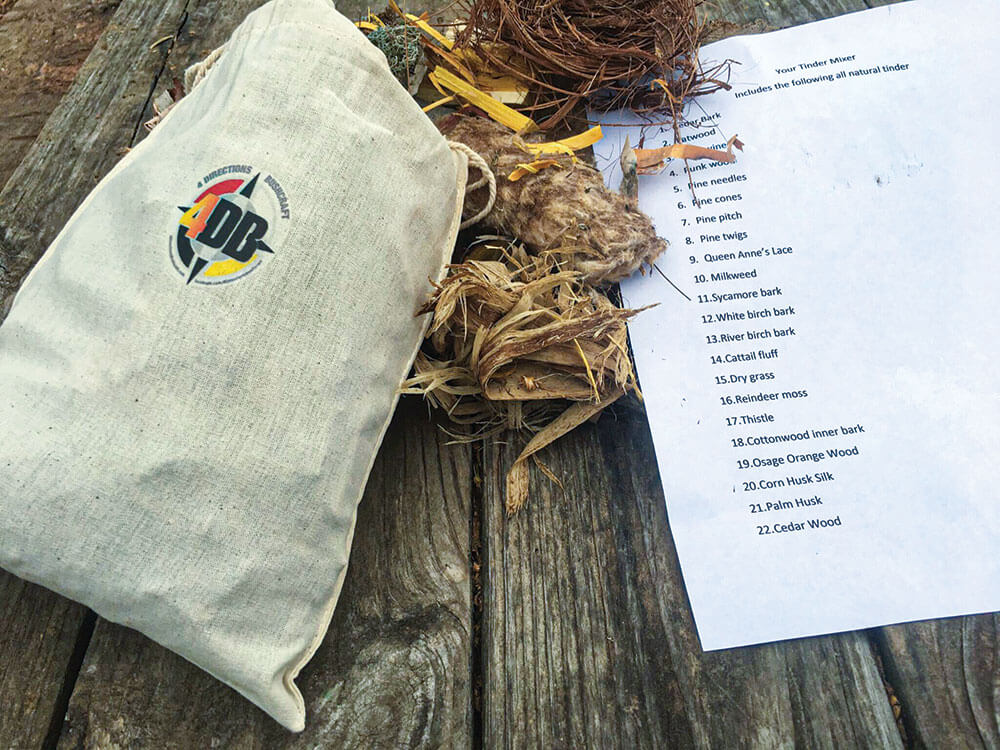
Having a supply of dry tinder before your adventure begins is good insurance. The Tinder Mixer is a combination of up to 21 different hand-selected, all-natural tinder materials crammed into an 8×10-inch, 100 percent cotton bag. The bag can be made into char cloth or refilled with tinder you collect. The assortment of grasses, bark, wildflower seed heads and fluffy materials varies by season, but it ignites quickly and easily with a variety of ignition methods. This is exactly the same stuff I look for when I’m out in the wild.
MSRP: $14.99
4DirectionsBushcraft.com
Light My Fire Swedish FireKnife
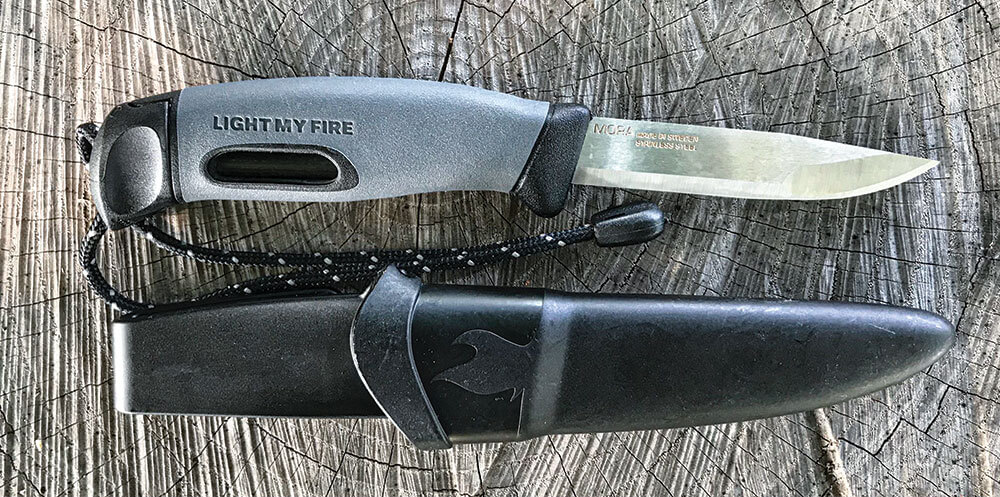
A good knife is essential for processing tinder and other tasks around the campsite, and the Swedish FireKnife fills this role quite well. The super-sharp Sandvik stainless steel knife blade measures 3.5 inches (made by MoraKniv of Sweden) and has a 90-degree-angled spine to easily produce blazing sparks from the weatherproof Swedish FireSteel that’s incorporated in the handle.
The included sheath holds the knife securely and features a belt clip and drain hole. The FireKnife is replaceable. This combination of a great knife and fire starter makes it an excellent choice to add to your kit.
MSRP: $42
LightMyFire.com
Suunto A-30 Baseplate Compass
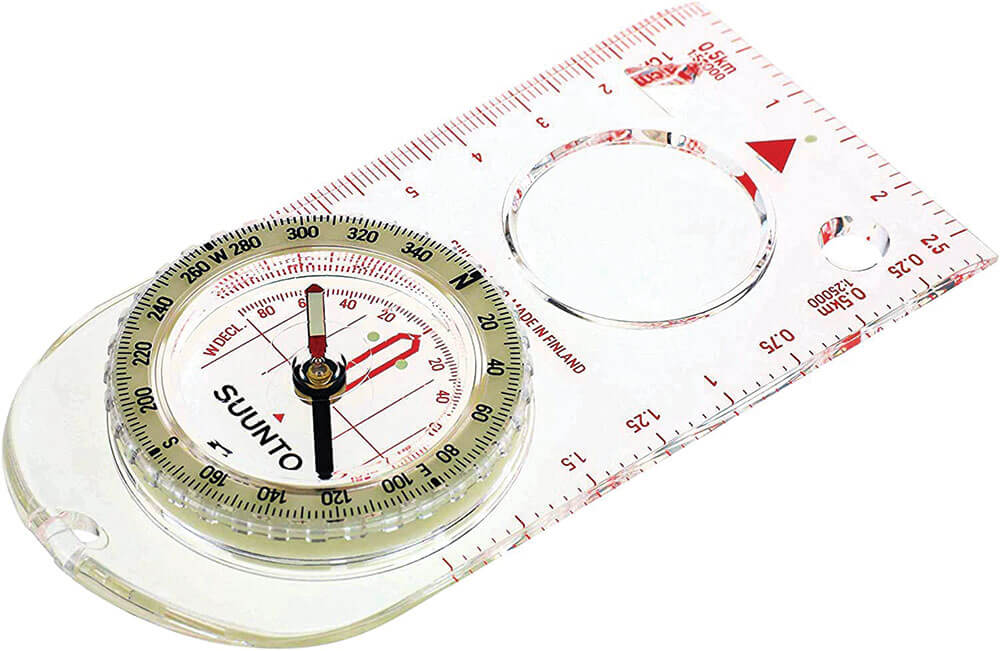
Baseplate compasses are designed for use with accurate topographic maps and can provide pinpoint positioning when used properly. However, that’s not all they can do. The magnifying lens molded into the baseplate of the Suunto A-30 compass is more than sufficient to focus sunlight onto tinder to create fire. The luminescent markings are easily visible in low light, and the liquid-filled capsule offers stable operation. I depend on my A-30 for finding my way—day or night—but I really like the fact that I can start fires with it too.
MSRP: $27
Suunto.com
A version of this article first appeared in the November 2021 issue of American Outdoor Guide Boundless.

